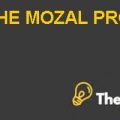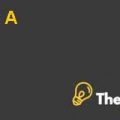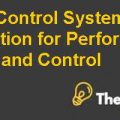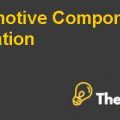
GM4107 – Group Assignment #1
PART 3: Pre-Determined Overhead Rate and Capacity
Q1.) Describe how the “production trick” can increase profits for a company using a normal costing system and expected capacity. As a manager, what concerns would you have with this approach?
However, the production trick will definitely increase profits in short term because using expected capacity, which uses the pre-determined overhead rate based on expected capacity of direct labor hours. However, overheads are absorbed on the full capacity of 40,000 direct labor hours but still sales will not increase from estimated sales, which can be produced using 32,000 direct labor hours, consequently, production will be in excess of estimated sales that will ultimately lead to overhead cost tied up in inventory. In addition to this, overheads of current month will be added in inventory that will be shown on the balance sheet and will not be charged to income statement; this means that fixed overhead cost of this month will not be charged to income statement of this month, consequently, profits will increase but this practice will tie-up working capital in inventory and will affect the working capital requirements.
On the other hand, normal costing system in which overheads are absorbed based on the estimated use of direct labor hours will not alter profits whether the production trick is used to produce more and absorb the pre-determined overhead in more units of product.
Q2.) Assume that the company uses practical capacity of DLH as the base to calculate the pre-determined MOH rate. Since product costs will decline, do you think that marketing should drop prices? Why or why not?
However, since the use of practical capacity in order to calculate per unit overhead will absorb lower overhead cost per unit, hence, the total production cost will be low as well but this does not justify the decrease in selling price because lower overhead absorbed rate per unit is only a method used for allocation of overhead in order to each estimate cost but still the total overhead cost will be the same. In addition to this, whatever costing system is used, actual fixed cost will have to be incurred for arriving at the final profit figures and if prices are decreased just because of the fall in pre-determined overhead cost then this will lead to decreased overall profitability of the company.
Q3.) What are your thoughts on whether and when a company (any company) should use practical capacity to determine overhead rates?
The use of practical capacity in order to determine the overhead absorption rate will be beneficial when a company has unused or excess capacity because if a company with unused capacity allocates its overheads using standard capacity; then this will over allocate the overhead cost to each unit and will lead to higher per unit cost, which will mislead management for making pricing decisions. On the other hand, if a similar company calculates its overhead rate using its practical or full capacity then this will give an accurate per unit cost and management will better able to reach a reasonable price for that product. Moreover, unallocated overhead cost will separately be shown so that it can be notified that what is the cost of having excess capacity
PART 5: Activity-Based Costing
Profitability Analysis Using Activity-Based Costing Techniques
Activity based costing is used to allocate overheads to different products; however, this costing system provides more relevant and accurate information regarding the profitability of each product type. Activity based costing system is used where the amount of unallocated overhead is substantial and relates to more than one products and this costing system requires identification of entire activities and cost incurred during a period; furthermore, the cost is pooled according to the relevant activities they relate to. However, activities and related overhead cost of Sukhodolov’s has been identified and the first element of selling overhead cost is sales personnel’s cost, which is a combination of sales representatives’ cost and sales accounts managers where sales representative only entertain orders from one category of customers, therefore, allocation of cost using number of orders they process will not be a reasonable basis; hence, this cost has been allocated based on the number of representatives assigned to each category of customer.
Meanwhile, in telephone order system, cost has been allocated using the number of telephone order received from each category of customer and since sales administration team is responsible for receiving and processing order via telephone, email and internet; therefore, sales and administration cost has been distributed using the total number of telephonic, email and internet order received from each category of customers.
Moreover, under marketing overheads, promotion, incentive and advertisement costs are allocated according to the percentage of advertisement and promotion activities
GM4107 – Group Assignment #1
PART 3: Pre-Determined Overhead Rate and Capacity
Q1.) Describe how the “production trick” can increase profits for a company using a normal costing system and expected capacity. As a manager, what concerns would you have with this approach?
However, the production trick will definitely increase profits in short term because using expected capacity, which uses the pre-determined overhead rate based on expected capacity of direct labor hours. However, overheads are absorbed on the full capacity of 40,000 direct labor hours but still sales will not increase from estimated sales, which can be produced using 32,000 direct labor hours, consequently, production will be in excess of estimated sales that will ultimately lead to overhead cost tied up in inventory. In addition to this, overheads of current month will be added in inventory that will be shown on the balance sheet and will not be charged to income statement; this means that fixed overhead cost of this month will not be charged to income statement of this month, consequently, profits will increase but this practice will tie-up working capital in inventory and will affect the working capital requirements.
On the other hand, normal costing system in which overheads are absorbed based on the estimated use of direct labor hours will not alter profits whether the production trick is used to produce more and absorb the pre-determined overhead in more units of product.
Q2.) Assume that the company uses practical capacity of DLH as the base to calculate the pre-determined MOH rate. Since product costs will decline, do you think that marketing should drop prices? Why or why not?
However, since the use of practical capacity in order to calculate per unit overhead will absorb lower overhead cost per unit, hence, the total production cost will be low as well but this does not justify the decrease in selling price because lower overhead absorbed rate per unit is only a method used for allocation of overhead in order to each estimate cost but still the total overhead cost will be the same. In addition to this, whatever costing system is used, actual fixed cost will have to be incurred for arriving at the final profit figures and if prices are decreased just because of the fall in pre-determined overhead cost then this will lead to decreased overall profitability of the company.
Q3.) What are your thoughts on whether and when a company (any company) should use practical capacity to determine overhead rates?
The use of practical capacity in order to determine the overhead absorption rate will be beneficial when a company has unused or excess capacity because if a company with unused capacity allocates its overheads using standard capacity; then this will over allocate the overhead cost to each unit and will lead to higher per unit cost, which will mislead management for making pricing decisions. On the other hand, if a similar company calculates its overhead rate using its practical or full capacity then this will give an accurate per unit cost and management will better able to reach a reasonable price for that product. Moreover, unallocated overhead cost will separately be shown so that it can be notified that what is the cost of having excess capacity.
PART 5: Activity-Based Costing
Profitability Analysis Using Activity-Based Costing Techniques
Activity based costing is used to allocate overheads to different products; however, this costing system provides more relevant and accurate information regarding the profitability of each product type. Activity based costing system is used where the amount of unallocated overhead is substantial and relates to more than one products and this costing system requires identification of entire activities and cost incurred during a period; furthermore, the cost is pooled according to the relevant activities they relate to. However, activities and related overhead cost of Sukhodolov’s has been identified and the first element of selling overhead cost is sales personnel’s cost, which is a combination of sales representatives’ cost and sales accounts managers where sales representative only entertain orders from one category of customers, therefore, allocation of cost using number of orders they process will not be a reasonable basis; hence, this cost has been allocated based on the number of representatives assigned to each category of customer.
Meanwhile, in telephone order system, cost has been allocated using the number of telephone order received from each category of customer and since sales administration team is responsible for receiving and processing order via telephone, email and internet; therefore, sales and administration cost has been distributed using the total number of telephonic, email and internet order received from each category of customers.
Moreover, under marketing overheads, promotion, incentive and advertisement costs are allocated according to the percentage of advertisement and promotion activities.................................
This is just a sample partial case solution. Please place the order on the website to order your own originally done case solution.













